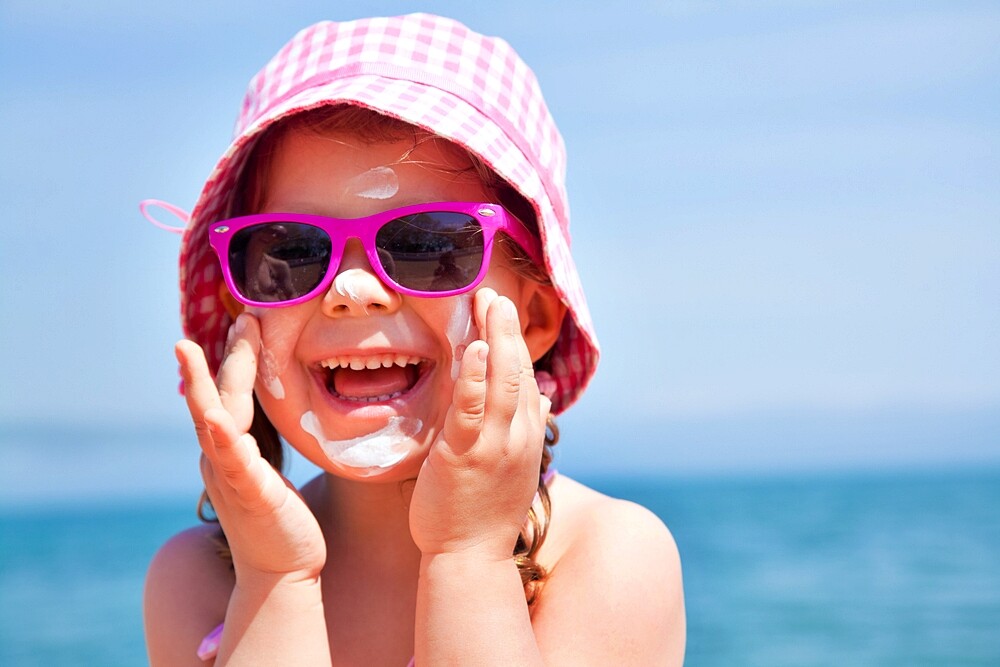Sun cream for children is a must, it protects the thin skin from sunburn. But which sun protection is the right one? Mineral or chemical filters? Spray, cream or roller?
Sun cream for children: It is that important!
We have long known how important sun protection is for children. We should not only apply cream in midsummer, but also in spring and autumn. Because the sensitive skin of children is up to five times thinner than the skin of adults. Its barrier function is not yet as pronounced and reacts much more sensitively to UV radiation. Sensitivity to the sun is further increased by the low pigmentation.
Melanocytes (the cells in which melanin, the ‘brown protective layer’ of the skin, is produced) do exist, but they are not yet working properly. The skin’s own protective mechanisms mature until the age of twelve. This is why it is so important to carefully protect the skin of babies and children!
Studies have also shown that sunburn in childhood increases the risk of skin cancer. Five or more sunburns in children and teenagers before the age of 20 increase the risk of skin cancer later in life by 80 percent.
Which sun cream is suitable for children?
The shelves in the drugstores are full of sun cream for babies and children. And every year innovations are added. But which product not only protects children’s skin from sunburn, but also does not harm the body and the environment? Every year the best sun creams are tested by Stiftung Warentest and Ökotest, but even a trained look at the INCI list will reveal which products contain microplastics or nano-particles. We tell you what you should pay attention to.
Which UV filter should it be?
- A difficult decision! Mineral sun cream does not contain chemical UV filters, which have been under general suspicion for years that they have a hormonal effect in the body and can trigger allergies. It lies on the skin and its particles of titanium oxide or zinc oxide reflect the sun’s rays without acting in the skin.
- Attention: Mineral sun cream is also available with nano-particles, which have the advantage that they do not whiten the skin as much as larger mineral pigments. However, they are also criticized: UV rays stimulate nano-zinc oxide and nano-titanium dioxide to produce free radicals. These aggressive molecules can damage the skin structure and DNA. The creams then contain the additional information “Nano” on the packaging.
- Many conventional sun protection products not only contain questionable filters, but often also microplastics that pollute our environment (we have been reporting on the effects of microplastics in cosmetics for years).
- However, they also have advantages: sun creams with chemical UV filters do not whiten and are easy to apply. They are also available as a spray and in the form of a scooter that children can use themselves. Some sunscreens now combine mineral and chemical UV filters.
What else is in kids sunscreen?
- A glance at the INCI list of the product reveals whether the sun cream contains microplastic: Mostly polyethylene (PE) or polypropylene (PP) is listed there. If you want to be on the safe side, use the website or app of Codecheck, which checks thousands of beauty products for their ingredients.
- Many sun creams for children contain fragrances to help them reach children’s noses. But they can also irritate the skin and provoke allergies. On some product packaging it is specially noted that they do not contain any.
- Dyes and preservatives should not be in the sunscreen, because they can also play a role in the development of a sun allergy.
The amount makes the protection: So much sunscreen needs children’s skin!
Spray, sun lotion or roller? Many sun protection products for children are now also available in a spray or roller version. Great idea, because easy application is very important for small cream mufflers. But: a sufficient quantity is crucial for protection. Light textures are quickly dosed too low, so pay special attention to this when using sprays and rollers.
The skin protection experts at Nivea have developed a quantity formula for sun protection for children:
- For 3 to 5 year olds, apply one stroke of sun milk in the length of 1 to about 1.5 middle fingers or 5 to 6 sprays of sun spray.
- 6-10 year olds: 1.5 to about 2 middle fingers or 7 to 10 sprays of sun spray.
- For older children and adults, apply one stroke of sunscreen from wrist to tip of middle finger or 15 sprays of sun spray.
- For children up to five years of age, double the amount should be applied to the face, neck and nape of the neck, as the head is disproportionately large for small children.
Can I also cream my child with sunscreen for adults?
Children’s skin is structured differently than adults’, it is much more permeable to the various ingredients of sun cream. Therefore – especially when it comes to sun creams for adults with chemical UV filters – it is better to use a sun product that is specifically designed for children’s skin.
Sun cream for babies
Some dermatologists recommend that babies in their first year of life should not be creamed with sunscreen, but should only be protected with UV clothing and not be exposed to the blazing sun at all. Pure mineral sun cream without nanoparticles and irritating ingredients may be applied to the skin from 6-12 months of age.
For UV protection of children’s skin
Not only sunscreen protects children’s skin from dangerous UV rays. Sun hats with UV protection (which depends on the type and density of the fabric) and UV clothing (swimsuits, but also shirts and trousers) are a good addition in summer. In addition, of course: Avoid the midday sun, reapply sunscreen after bathing and don’t stay in the sun too long!

